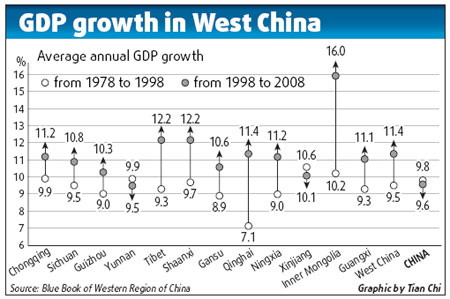
|
CHINA> Regional
 |
|
Blue book: West China still struggling
By Tan Yingzi (China Daily)
Updated: 2009-07-14 07:58 Despite massive exploitation of its natural resources and efforts made via the Go West Campaign, the economy of West China still lags behind the rest of the nation, experts said as the latest Blue Book of the Western Region of China was released. The book, a report on economic development in the western region, has been published annually since 2005.
 It reveals that while the area has seen a spike in projects that tap into its hydroelectric and metal ore potential, it has not yet closed the gap on wealthier provinces and remains the poorest region. "The reform of our financial system is the best way to bridge the widening gap between the western and eastern parts of the country," said Yao Yang, deputy director of the China Center for Economic Research at Peking University. Yao said additional regional banks and a local capital market would encourage more investment in the region. Cai Jimin, deputy director of the Institute for Economic Research at Tsinghua University, said the exploitation of West China's rich natural resources has not translated into a financial windfall "because of the unreasonable tax system of natural resources and low compensation standards".
In recent years, West China has experienced its fastest period of economic growth since the founding of the People's Republic in 1949. The region is enjoying an average annual GDP increase of 11.42 percent, which is higher than the country's average of 9.64 percent. In 1999, West China's GDP increase was just 7.2 percent. And West China's average GDP per capita has doubled in recent years from 4,122 yuan ($600) to 13,186 yuan ($1,933).
But the region's GDP was only 17.8 percent of China's total in 2008 and its average GDP per capita was only 41.09 percent of that in the east. People in West China, despite the improvements, are earning less than the country's average. Eight western provinces were among the 10 lowest income areas in 2007. Gansu province had the lowest average income - people there earned 42.34 percent of the average income in Shanghai. The Blue Book was compiled by the Centre for Studies of China Western Economic Development at Northwest University in Xi'an, Shaanxi province. China initiated its western development strategy in 1999 to boost the underdeveloped area, which includes 12 provinces, autonomous regions and Chongqing municipality. West China is home to a quarter of the country's 1.3 billion population. It is also home to most of China's ethnic minorities - including Tibetans, Inner Mongolians and Uygurs. It boasts rich natural resources, including coal and oil - and cheap labor. Policies such as heavy government investment, preferential tax rates and flexibility have been implemented to boost local infrastructure and environment. In the past decade, nearly 1.74 trillion yuan has been poured into 102 major projects. The annual growth rate in investment in fixed assets is more than 20 percent. But it lags behind, in part, because of historic underdevelopment, the report says. Further advances are planned for the next 10 years, said Li Yingming, deputy director of the Department of Western Region Revitalization under the National Development and Reform Commission. |
主站蜘蛛池模板: 毛片免费在线观看网址 | 中国一级毛片免费观看 | japanese日本tube色系 | 日本波多野结衣视频 | 日本欧美韩国一区二区三区 | 热99re久久精品这里都是免费 | 久久福利影视 | 国产成人久视频免费 | 久热免费在线观看 | 成年人色网站 | 国产手机在线国内精品 | 黄色毛片免费看 | 成人永久福利在线观看不卡 | 黄黄的网站在线观看 | avtom影院入口永久在线观看 | 免费人成在观看 | 日本美女作爱 | zztt40.su黑料不打烊官网 | 国产日韩精品欧美一区 | 你懂的国产精品 | 成人18视频在线 | 国产欧美日本亚洲精品五区 | 一级片aaaa| 在线免费观看日本视频 | 成 人 a v黄 色 | 成人欧美在线观看 | 韩国激情啪啪 | 亚洲美女在线观看亚洲美女 | 欧美精品国产一区二区三区 | 一级片中文字幕 | 久久久这里只有精品加勒比 | 一级无毛片| 在线国产欧美 | 亚欧国产 | 欧美 另类 精品一区视频 | 欧美一级日本一级韩国一级 | 国产精品jvid在线观看 | 国产成人精品免费视频网页大全 | 欧美日韩一区二区高清视 | 亚洲精品国产精品精 | 国产日韩精品一区二区在线观看 |